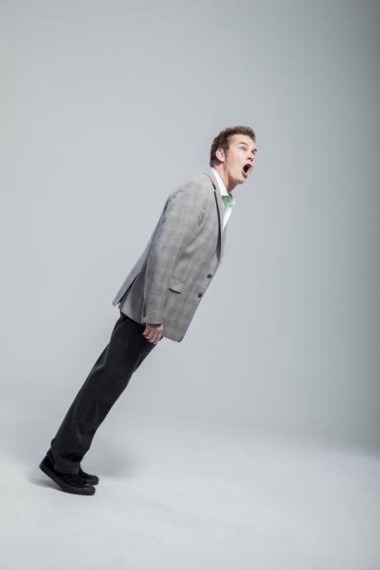Brian Regan has made audiences laugh for three decades. He still remembers what it was like at first to stand up in front of a crowd and try to get that laughter started. “It’s scary. It’s also exhilarating. It’s wrapped up in one big emotional package—the fact that you’re scared to death, yet you’re intrigued enough to hop up there,” Regan says. “What is it about this that makes me want to do this when I’m terrified? What is it about this microphone, this stage? That quest to get a room full of people laughing is so overwhelming—what makes me walk through the fear?”
Watch him do his thing, and you’d never think of fear. Regan always seems to be in control, steering audiences toward inevitable laughs with the kind of confidence that comes from long acquaintance with the stage. All the same, he says, telling a good joke from a bad one is a process of trial and error. “When you think of something, you have an internal feeling about whether it makes you laugh,” he says. “I always have a philosophical dilemma—if I think something’s funny and I get on stage and say it and nobody laughs, is it still funny? I still think it’s funny. It’s sort of like if a tree falls in the woods—if one person thinks something is funny, is it funny? The only way I’m going to know is if I get on stage and throw it out there.”
It’s that willingness to take the risk, in part, that makes somebody a comedian rather than just someone everybody thinks is funny. About that kind of difference, Regan says, “The way I describe it—there’s two parts to getting laughs. First the pins have got to be set up, and then you have to knock them down. When you’re funny with your friends, the pins are already set up. Everybody knows Jane’s a cheat, or Fred is a womanizer, and you just have to say the funny part. On stage, you have to set up the pins. Nobody knows nothing from nothing.”
Seen through that lens, it’s remarkably clear just what Regan is up to in his comedy. It’s high-energy stuff—he acts things out and makes faces as much as he talks—but there’s a clear ramp-up, a setting of the pins. He draws scenes, then, in classic fashion, he notes the absurdities and frustrations most everyone feels in those situations. Then something else happens, something more interesting yet.
When he tackles that perennial subject of comedians, flying, for instance, he describes the usual shuffle of boarding a plane. He then narrows his focus to the first-class passengers. He notes their habit of busily working as people go by as if to say, “Right now we’re making money. Go, get in the back! Close that curtain—I don’t want to see ’em! Even in my peripheral!”
It’s well-played situational comedy, and by this point in his routine, the silliness arrives fast and furious, and a rib-sore audience is primed for one of those risky moments Regan talks about. He imagines sitting at the back of the plane, where he gets the one leftover meal. He describes the attendant’s sales pitch for a frozen fish head: “The eyeball’s in there and the skeleton’s coming out. It comes with a turnip and a spork.” It’s a strange turn, one that doesn’t have the same obvious appeal, but he delivers it with the same manic energy and the laughs don’t ease up. He’s knocked down the pins.
Another hallmark of Regan’s style is tracing the origin of something absurd. In one routine, he imagines the meeting which gave birth to the inane song from the kids’ show Dora the Explorer, “I’m the Map.” In another, he speculates about the naming of the walkie-talkie.
“My stuff usually tends to be these single-comment bits, little vignettes, situations, almost little tiny plays—me and an eye doctor, me and an inanimate object. Usually it’s a common experience that we all share. I’m telling you about it, using me as an example. I’m not a ‘two guys walk into a bar’ kind of comedian.”
Neither is he a comedian whose work has to be avoided when kids or the particularly buttoned-up are around. Oddly enough, Regan says that wasn’t something he really thought out. “It was not really a choice at the beginning—I just tended not to think that way comedically. I had a handful of jokes with a four-letter word—but it was 90-95 percent clean. I’d get comments after like, ‘Hey, I enjoyed the show.’
“I did shows with nothing blue in them at all, and the comments were markedly different. People would say, ‘We loved the show! We’re coming back, and we’re bringing Aunt Edna!’”
All the same, he says, “It’s not a prude thing. There are people who work blue I love, like Richard Pryor, who was maybe the greatest standup ever.”
Early on, Regan decided he wanted to be on stage. “When I was in college I knew I wanted to be a comedian,” he says. “A comedian performed at our school and I interviewed him before the show. I found out that he was getting $800 for the show. I’m a college student who thinks if he has $5 in his pocket for the weekend, he’s set. I figured I like making people laugh, but I could definitely do $800.”
This led him to working at a comedy club. “I’d cook burgers, and they’d let me go on stage for two and a half minutes.”
Regan seems to still love what he does. “What I love about standup is that people are honest—they’re not gonna fake laugh at you. You know that’s something that’s real—you can trust that connection. You can’t trust applause—‘the guy tried, we’ll applaud’—but people don’t fake laugh.”•
Brian Regan: April 13, 8 p.m., $35-55, The Calvin Theatre, 19 King St., Northampton, (413) 586-8686, iheg.com.



